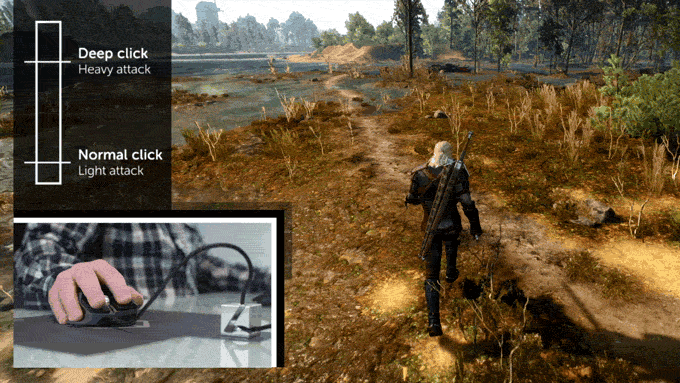It seems like every day I wake up there’s a new gaming mouse on the market claiming to be the next best thing since sliced bread. When you get down to it there isn’t a lot of change to be had when it comes to the good old PC mouse – it’s a tried and true input method and people don’t want to deal with someone messing with it. The folks behind the Swiftpoint Z did just that yet managed to do it in a way that only adds to what we think a mouse can accomplish without taking anything away. If you’re looking to enhance your mouse experience more than you thought possible this review is for you.
Technical Specifications
- MSRP: $229.00
- Right-handed ergonomic design
- 200 – 12,000 DPI Pixart PMW3360 Sensor (adjusts in 100 DPI increments)
- Standard 1000Hz polling rate
- 12 buttons directly under fingers including two under the thumb
- Pivot and Tilt sensor provides six-axis in-air control of pitch, yaw, and roll for flight in games.
- Five analog force buttons supporting ‘deep click’ (left and right click, middle mouse, left and right ‘fingertip buttons’)
- 16 different possible bindings utilizing trigger buttons and deep click analog buttons
- 2.1m (7′) braided USB cable
- Includes flight stick extender, tall and short trigger caps, long and short ‘fingertip’ caps, adjustable tilt feet, and high-quality travel case
- OLED Display for on the fly adjustments
- 32bit Microprocessor w/ 256kb onboard memory
- The main left and right buttons rated for 20 million clicks
The Package
- Outside of SwiftpointZ Box. Rocking the CES2017 Innovation Award
- Nice quality travel case, zippered with a embossed logo.
- Travel case opened displaying all accessories. Everything fits perfectly.
The packing for the Swiftpoint Z is hands down the nicest mouse packaging I’ve encountered to date. Usually, the mouse comes in some clear plastic holding it in place in a flimsy cardboard box. Don’t get me wrong, there is absolutely nothing wrong with that, but right out of the gate you can tell that Swiftpoint is playing a different game compared to everyone else.
Initially, I was a little overwhelmed as I had no idea what any of the accessories on the left of the case were for and that feeling of being slightly overwhelmed is going to be a recurring theme with the Z when you first get it. It’s a mouse that comes with A LOT and best digested in smaller bites. As it turned out after looking at the user manual I had a little bit of assembly to do and needed to pick out which trigger buttons I wanted to use and which fingertip buttons. This is 100% personal choice so I recommend trying out both to see which ones you have an easier time utilizing during gameplay. The trigger buttons are the ones that end up resting under the base of your finger so you can click them by straightening out your finger and applying downward pressure. The fingertip buttons are just what they sound like – you bring your fingertips down towards the base of the right or left mouse button and you can find them.
While many of you reading may not find any use to ever transport your mouse around I do really appreciate the effort that Swiftpoint put into having a reliable and quality method to storing your mouse and it’s additional parts. I’ve used the travel case already a few times (I actually travel a fair amount) and its existence has made the Swiftpoint my go-to travel mouse.
Gameplay and Software
- Most of the buttons can be seen in this shot.
- This attachment makes the mouse an analog joystick of sorts with full control over pitch, roll and yaw.
As I said before this mouse was something I had to chew off in bites over the course of a few days to prevent myself from getting overwhelmed. To me, it’s main selling point and strength is simultaneously one of the main drawbacks: the sheer amount of features it’s capable of can be overwhelming if you try to digest it all at once. So after spending about a day just using it as a normal mouse, I dove into making a profile for World of Warcraft to throw some of my keyboard bindings onto the mouse.
Now just about any mouse out there with more than the standard amount of buttons acts the same way when it comes to bindings. Go into the software, click the button you want to bind, assign it a keyboard binding instead and ‘Viola!’ you’re done. But seeing as this wasn’t a normal mouse I wanted to try one of the features that intrigued me the most: deep click.
Deep click refers to the Swiftpoints ability to sense how much pressure is being applied to mouse clicks. Five mouse buttons have this feature: left click, right click, middle mouse, left fingertip and right fingertip. In the software I set the OLED screen on the mouse to display what force is being applied on click and found that I am quite the dainty mouse clicker averaging about 10%.
The software was really easy and intuitive to use. After clicking on the mouse button I wanted I was presented with my press and release buttons including those for ‘Force’. I was able to set the point I wanted to the force to trigger (I did 50% for myself) as well as what actions I wanted to happen at that point. I set a vibration so I had feedback to know I hit the point and also set it to pop off the binding for my mount. This was just my first test and it was just the beginning. To say it worked phenomenally well would be an incredible understatement. In short order, I found myself binding all the fast items you would need in WoW – interrupts, potions, etc – that saving a split second not using your keyboard for could turn the tide of a PvP battle.
The buck doesn’t stop in WoW either. Player Unknown’s Battleground became an entirely new experience as well. A feature I haven’t really talked about yet is the mouse’s tilt ability. This may sound annoying to some (I thought it was going to be) but it’s really powerful. The mouse, with just a little bit of input from you, can be tilted about 10 degrees to the left or right while still maintaining use of the sensor for aiming. This tilt can be bound to hold a specific key like leaning in PUBG (or holding a modifier key in an MMO game to open up a whole new set of bindings).
This lean feature did take time to get used to. I had to battle months of muscle memory of using Q and E as well as learning how to perform the lean with the mouse without compromising my aim. The results after a day of practice, however, were worth the fumbling around. It felt natural and incredibly smooth. I found myself wondering why no one had thought of implementing mouse leaning yet because a flick of the wrist is so intuitive compared to holding down Q or E (or toggling if that’s your thing). Check out this short YouTube clip from Swiftpoint as an example:
And here’s another quick example from Swiftpoint of what you can accomplish with their analog force detection:
The fact of the matter is that I could go on and on about the different things that can accomplished with this mouse. You can be running around in Far Cry 5, jump in a helicopter and just by lifting up your mouse suddenly have full control over the flight controls – almost like you’re holding a little mini helicopter in your hands and controlling it just by moving it around. If you have the will to dive head first into the controls and features the accomplishments of the Swiftpoint Z seem to be nigh limitless.
Conclusion
There’s no way around the fact that the Swiftpoint Z is probably one of, if not the, most expensive mouse on the market. The MSRP is a very hard pill to swallow but has the upside of delivering more features than any other mouse currently on the market. The Swiftpoint Z accomplishes what it sets out to accomplish – to be the best mouse at whatever task it’s put against. You just have to have the patience and will to configure it exactly to your needs. So while it can be overwhelming to start, if you slowly digest this feature-rich peripheral you’ll find yourself with a mouse that will deliver time and time again with every game you play.
If you like what you’ve read here, head on over to this link and pick up the Swiftpoint Z for only $149!















